Ontario Steelhead
Steelhead: Ontario steelhead are arguably the hardest fighting fish and they could be the hardest and fastest pulling fish that often leap multiple times with seemingly endless endurance. Steelhead are a favorite of many anglers and anglers who fish these great fish often refer to themselves as steel headers.
What is a Steelhead: A simple definition is that a steelhead is a migrating rainbow trout that leave the rivers for oceans or lakes, versus a rainbow trout that spends their entire lives in a river.
Common Steelhead Names: Local anglers sometimes refer to steelhead as Bows, Rainbows or just Rainbow trout and if you spend enough time on a steelhead river you may hear the terms Shakers, Silvers or Chromers because of their silvery look they get from being in the clear waters of the lake. If you hear the common term Shaker, a shaker is a smaller steelhead, usually about 18 inches or less and they get that name for the rolling and twisting style of fight the often give anglers.
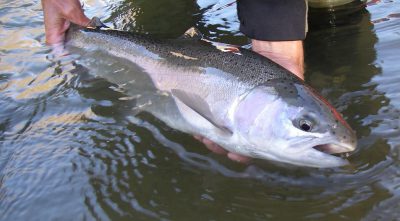
A fresh run fall steelhead
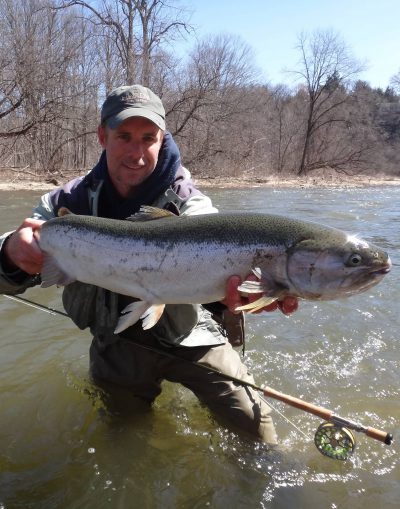
Jordan with a spawned out female steelhead
Regulations On Steelhead
Regulations: So as not to confuse anyone and since the Ontario Ministry of Natural Resources (OMNR) lists them in the regulations as rainbow trout I’ll refer to them as rainbow trout or steelhead from here on. Please go to the OMNR website and read through the regulations carefully before going fishing. For more tips and info on the Ontario Fishing regulations go to the Ontario Fishing Regulations Page .
Steelhead Life Cycle: Steelhead are born in a river where they spend their first 1 to 3 years before they migrate to one of the great lakes where they will feed on baitfish and quickly grow very big. After a year or two in the big lake they will often double their size and return to the same river they were born in to spawn. Steelhead can spawn 2 to 3 times over a period of years before they die and they can reach sizes over 29 pounds in Ontario.
Steelhead History
History of Naturalized Steelhead: The first substantial runs in Ontario are believed to be from the Nottawasaga river where steelhead escaped in early 1890’s from a trout farm on the Pine River, a tributary of the Nottawasaga River and then returned to spawn on their own.
Since then most or all rivers and creeks flowing into the great lakes have some steelhead in them due to huge stocking efforts from the USA and OMNR.
At this time most Ontario steelhead reproduce naturally with only minimal supplemented stocking done by the OMNR and the percentage of wild versus stocked fish varies from one river to the next.
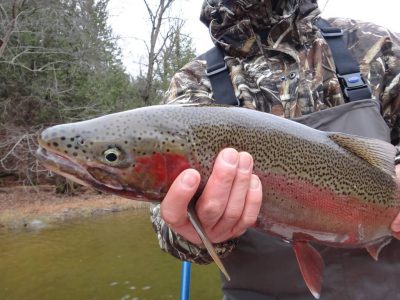
A colorful male steelhead

Jordan with a spawned out female steelhead
Steelhead Identification
Identifying Steelhead: A resident stream rainbow trout and a steelhead can sometimes be hard to tell the difference because after a steelhead enters a river it starts to lose that silver sided look and often takes on more colorful markings which can be very similar to a resident rainbow trout.
When the steelhead first enter the river they are usually very bright with silver sides and can easily be identified.
Steelhead also tend to be much bigger then resident rainbows which rarely get bigger then 20 inches. The closer to the spawn and the longer a steelhead is in the river the more colorful the steelhead can be as seen in the above picture.
The males can often grow larger teeth and a kype or hooked jaw with very dark colors including red cheeks and a red stripe with increased spotting like the steelhead picture above.
Also notice the steelhead in the top picture is a male and the steelhead in the bottom picture is a female.
The females tend to have smaller more rounded heads with their eyes closer to the end of their nose and the males tend to have bigger heads with a more pointed nose and the eyes are set further back. Releasing females helps maintain good populations and is highly recommended. Males tend to have more color on the cheeks but some spawning females can also have color in their cheeks so that’s not always the best way to tell the difference. Normally once the spawning steelhead returns back to the lake they heal their wounds from spawning and start to turn silvery again.
Steelhead Runs
Steelhead Runs: When the steelhead enter the river they often enter in large numbers and we call this a run. They are running up the river to spawn. We are lucky to have steelhead in many of our rivers from September until mid to late May giving anglers 9 months to target these awesome fighting fish. With some exceptions it’s possible to even find steelhead in the rivers even in the middle of the summer giving anglers 12 months of steelhead fishing. We call these summer fish “hold over’s” and they are often fish that ran the river in late spring and got trapped in the river when the water levels dropped and then became to low for them to safely move out of the river and back to the lake.
With most trout species in Ontario, catching only 1 or 2 fish over 20 inches is considered a great day, but with steelhead its not uncommon for skilled anglers to catch 5 or more over 20 inches in a day and if you learn how to predict the runs accurately you could catch 20 or 30 big steelhead in a day.
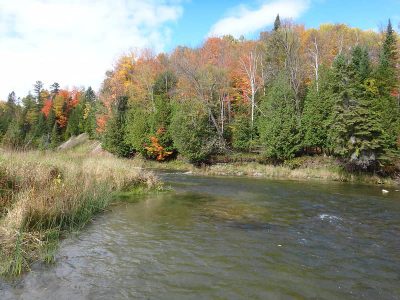
Fall Fishing
Spring Steelhead: the steelhead will start to run up the rivers in late February if the conditions are good. They will even move up under the ice at times. Mild days from late February and early March before the big snow melts can be excellent fishing. Once the rivers settle from any rains or warm snow melt days the steelhead fishing can be very good again and can continue to be good into mid-May. I recommend booking your guide trip in April when the rivers are more stable and the weather is better but anytime if march works for me to.
Fall Steelhead: On many rivers the peak runs often occur after large rains starting in late September or early October and can continue with each rain until the river freezes or gets to cold which often slow or halt their migration. Increased water flows are often the main factor for the fish to enter and move up the river since the increased water allows them to move up the river easier.
It is best to book my fall guide trips from mid October to Mid-December. Often the best steelhead and the most numbers of fish in the river is from the first week in November to the First week in December.
Although steelhead will start running up rivers as early as late August on some rivers about 95% wont actually spawn until late winter or early spring which means sometime in late February, March or April.
So why do they run in September, October and November if they don’t actually spawn until the spring? As a guide I get that question a lot. Some call this fall migration a false run and although there are many theories as to why they run the rivers in the fall nobody is really 100% sure why they run in the fall. Some say its because they follow the salmon up to feed on the highly nutritious salmon eggs. Others say its in their nature to head for the spawning grounds very early because on some west coast rivers they need to travel hundreds of miles up rivers traversing multiple obstructions so they leave early to be sure they make it to the prime spawning grounds on time. Some say it’s a water temperature thing that triggers the runs and those temps occur in the fall and in the spring.
Regardless of their reason many anglers know the fall steelhead can often be the hardest fighting fish due to them being in good health from feeding all summer and from the water temperatures being perfect.
Winter Steelhead: There are days in late December through late February when the temperatures warm above freezing for a few days and if the rivers thaw out enough to fish the steelhead fishing can be very good.
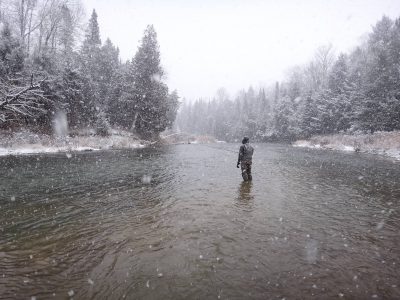
The Best Time to Book
The best time to book: The best times to book a trip for steelhead is usually mid October to the first week in December with peak fishing the first week of November and the 3 weeks following, which is when double digit days of steelhead caught are most common. Some years with low water in early fall may mean it’s more common to have great high number days throughout December instead, with the added bonus of a lot less anglers out fishing at that time.
Steelhead Rivers: I think about 90% of rivers flowing into the great lakes get some steelhead in them. There are however some well known rivers that get substantial runs and we primarily guide some of these rivers. For these rivers check out our river page.
Best Steelhead Baits
Productive Baits for Steelhead: Some of the most productive baits for fall steelhead include plastic steelhead worms, roe bags, beads, flies, spinners, spoons, jigs and sometimes even minnow style crank bait lures.
Some anglers will use small garden worms or even full sized dew worms right up until the river starts to freeze but i find inmost cases the plastic worm work just as well.
Fish Eggs As Bait: One of the most common baits for steelhead is the roe bag. Roe bags are small fish eggs within a mesh sack. The eggs can be salmon eggs, brown trout eggs, rainbow eggs or even brook trout eggs.
You can buy roe bags pre-tied or buy the eggs and the tying materials and then tie them yourself. We recommend using store bought eggs since these eggs often come from fish farms and do not deplete the natural steelhead numbers.
The picture above shows some tied up brown trout eggs from Fishheads Canada and the mesh I used to tie them.
A great place to get loose eggs and all the tying materials is from FishHeads Canada which is Ontario’s premier on-line store for steel headers.
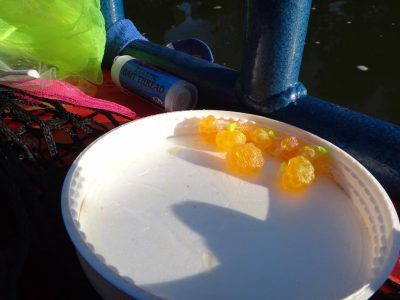
The Debate About Roe: Some anglers still believe that harvesting eggs from a fresh fish will allow them to catch more fish because it’s the best bait going but it’s my opinion that it’s not a fact. I believe store bought eggs and other artificial baits combined with good skills will catch you just as many fish or more then fresh eggs and I have proven this hundreds of times.
It’s not uncommon in my boat while guiding to have one angler using pink plastic worms, store bought roe or beads, and the other angler using fresh roe. I’ve seen countless times the angler with the worms or beads catching as many fish or even more. I’ve also had many days when we speak with other anglers on the river all using roe and they’ve caught very few fish on their roe when we have been doing great on other baits.
In-fact I don’t use fresh roe harvested from a fish I’ve caught anymore and I all my Roe from FishHeads Canada which comes from local farm raised trout. If you come our with me and would like to use your own roe I’m OK with that too.
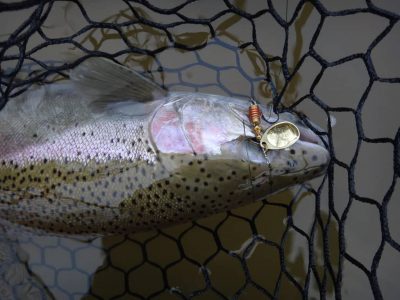
Steelhead Tactics
Float Fishing For Steelhead: Float fishing for steelhead doesn’t mean floating down a river for steelhead however that is one way of targeting steelhead in Ontario. Float fishing is the most popular way to present a roe bag or other bait to steelhead by using a “float” or as some may call it a “bobber”. For more information on float fishing and Centerpin fishing go to our Float Fishing page.
Fly Fishing For Steelhead: go to our fly fishing for steelhead page for more detailed information.
Spin Fishing For Steelhead: Anglers either bottom bounce a weight with a hook and roe bag along the bottom carefully feeling the line for any hesitations or pulls that may indicate the subtle take of a steelhead.
Anglers will also use baits under a float: See more at the Centerpin page
Lures for Steelhead: Lure fishing for great lakes steelhead can be very effective under the right conditions. When spin fishing some anglers prefer to throw lures like flatfish, kwikfish, spinners or crank bait lures like Rapalas.
We do guide anglers that want to spin fish for steelhead and trout. Our most productive spin fishing method is to cast Mepps, Vibrax or Panther Martin spinners or crank bait lures but we also jig fish and float fish with spinning reels. The strikes when using lures are usually aggressive so be prepared to have some fun.
BONUS TIP OF THE DAY
Change Is Good: To many anglers get caught in a rut and fish the same methods, the same bait and the same type of water all day long.
As a guide I’m always watching and thinking. If the fish are biting why? If the fish aren’t biting why? I’m constantly trying to analyze the situation and consider changes to see if I can improve on what we are doing.
If they’re not eating pink roe bags, than try another color based on the current conditions. If roe isn’t working try a fly, rotate through multiple flies until your convinced it is or isn’t working, try a bead, try a worm and if that doesn’t work try another spot and repeat.
And it’s not just about the bait, I’ve had days on the water where the popular pools are slow and nobody seams to be doing well, and then I move and fish pocket water or water so fast or so shallow everyone walks by it and I get fish, after fish, after fish.
I remember a recent trip where I said to my client we should catch 10 times more steelhead today than everyone else is catching and we’re not going to even fish were the other guys are. We spent the entire day pulling fish out of fast water pockets, smaller than a pool table. I knew these fish weren’t holding in the slow pools based on the conditions and the fact I fished the same stretch the day before and knew where they were.
We spoke to a dozen guys that day and most said the fishing was really slow with only one or two fish caught but we landed over 10 fish and hooked over 15 and not once did we fish a pool.
If one thing is not working, try something different, you may be surprised.
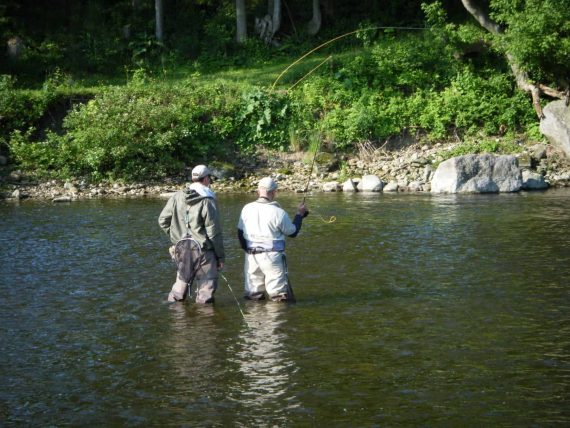
RIVER FISHING TIPS AND ADVICE
Have you ever wanted to know what the guides know? Now you can!
Anglers ask me all the time about what rods and reels and other gear that I recommend, or they ask me about my best flies, or my best methods or even which rivers are good to fish. I build a website that cover’s all of that and more . . . . . You should checkout our sister site where I tell you exactly what gear you need and i give you free tips and tricks to help you catch more fish. Check out www.ontariotroutandsteelhead.com
